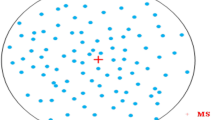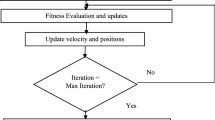Abstract
Industrial applications and automation controls are closely connected with heterogeneous Wireless Sensor Network (WSN); thus, Industrial Internet-of Thing (IIoT) enhances the productivity, scalability, and flexibility of the operations. However, in many cases such as tracking a device or service localization becomes very crucial to state back the operations at times. Existing literature show a various localization solutions, but they face the drawbacks of high energy consumption, and non-coherence in heterogeneity. Besides, in a WSN-based IIoT, non-cooperativeness exists among nodes due to various system and environmental parameters, which make the system resource-exhaustive. In this paper, we introduce a novel localization algorithm that addresses the above-mentioned problems. We call our proposed algorithm RAnge-free Power efficient COoperative Localization (RAPCOL). Specifically, the use of co-operative beacon nodes to broadcast the information to Base Station and low energy consumption highlights the novelty of the work. RAPCOL uses weight metrics for selecting optimal cooperative beacon nodes to prolong the network lifetime. We also introduce an Improvised Particle Swarm Optimization (IPSO) that credits in the contribution in RAPCOL. We run a overall nine sets of experiments to analyze the localization accuracy, effect of beacon nodes, sensor nodes, network connectivity, and sensing field, error frequency, residual energy, time, and network lifetime. A comparative study with the existing localization models shows that RAPCOL is \(30\%\) better than the existing models in terms of accuracy and resource consumption. We observe stable performance of RAPCOL with a differentiated effect of beacon nodes and sensor nodes. We also observe that our proposed IPSO \(20\%\) better in fast convergence to the optimal solution. Though RAPCOL localization time is \(12\%\) higher than other existing protocols, RAPCOL’s accuracy and energy saving mechanism make it efficient for IIoTs.















Similar content being viewed by others
Data availabiltiy
Enquires about data availability should be directed to the authors.
References
Satrya, G.B., Shin, S.Y.: Evolutionary computing approach to optimize superframe scheduling on industrial wireless sensor networks. J. King Saud Univ. - Comput. Inf. Sci. 34(3), 706–715 (2022). https://doi.org/10.1016/j.jksuci.2020.01.014
Deebak, B.D., Memon, F.H., Dev, K., Khowaja, S.A., Qureshi, N.M.: AI-Enabled Privacy-Preservation Phrase with Multi-Keyword Ranked Searching for Sustainable Edge-Cloud Networks in the era of Industrial IoT. Ad Hoc Netw. 125, 102740 (2021)
Soares, C.A.R., de Souza Couto, R., Sztajnberg, A., do Amaral, J.L.M.: POSIMNET-R: an immunologic resilient approach to position routers in industrial wireless sensor networks. Expert Syst. Appl. 188, 116045 (2022)
Xingfa, Shen, Zhi, Wang, Youxian, Sun: Wireless sensor networks for industrial applications. pp 3636-3640. (2004) https://doi.org/10.1109/wcica.2004.1343273
Kumar, S.: Collaborative processing using the internet of things for post-disaster management. In: Nandan Mohanty, S., Chatterjee, J.M., Satpathy, S. (eds.) Internet of Things and Its Applications. Springer, Cham (2022)
Feng, S., Shi, H., Huang, L., Shen, S., Yu, S., Peng, H., Wu, C.: Unknown hostile environment-oriented autonomous WSN deployment using a mobile robot. J. Netw. Comput. Appl. 182, 103053 (2021)
Abbad, L., Nacer, A., Abbad, H., Brahim, M.T., Zioui, N.: A weighted Markov-clustering routing protocol for optimizing energy use in wireless sensor networks. Egypt. Inform. J. (2022). https://doi.org/10.1016/j.eij.2022.05.001
Wen, J., Yang, J., Wang, T., Li, Y., Lv, Z.: Energy-efficient task allocation for reliable parallel computation of cluster-based wireless sensor network in edge computing. Digit. Commun. Netw. 9, 473 (2022)
Hong, Y., Luo, C., Li, D., Chen, Z., Wang, X., Li, X.: Energy efficiency optimization for multiple chargers in wireless rechargeable sensor networks. Theor. Comput. Sci. 922, 193 (2022)
Liu, X., Yin, J., Zhang, S., Ding, B., Guo, S., Wang, K.: Range-based localization for Sparse 3-D sensor networks. IEEE Internet Things J. 6(1), 753–764 (2019)
Vinayakumar, R., Alazab, M., Srinivasan, S., Pham, Q.V., Padannayil, S.K., Simran, K.: A visualized botnet detection system based deep learning for the internet of things networks of smart cities. IEEE Trans. Ind. Appl. 56, 4436 (2020)
Niculescu, D., Nath, B.: Ad hoc positioning system (APS). In: Global Telecommunications Conference, 2001. GLOBECOM’01. IEEE, vol. 5, pp. 2926-2931 (2001)
Roberts, M.K., Ramasamy, P.: Optimized hybrid routing protocol for energy-aware cluster head selection in wireless sensor networks. Digit. Signal Process. 130, 103737 (2022)
Gavali, A.B., Kadam, M.V., Patil, S.: Energy optimization using swarm intelligence for IoT-authorized underwater wireless sensor networks. Microprocess. Microsyst. 93, 104597 (2022)
Yetgin, Halil, Cheung, Kent Tsz Kan., El-Hajjar, Mohammed, Hanzo, Lajos Hanzo: A survey of network lifetime maximization techniques in wireless sensor networks. IEEE Commun. Surv. Tutor. 19(2), 828–854 (2017)
Amutha, J., Sharma, S., Sharma, S.K.: An energy efficient cluster based hybrid optimization algorithm with static sink and mobile sink node for wireless sensor networks. Expert Syst. Appl. 203, 117334 (2022)
Liu, Z., Feng, X., Zhang, J., Wang, Y., Li, T.: A new range-free localization algorithm based on amendatory simulation curve fitting in WSN. Int. J. Distrib. Sens. Netw. 11(5), 634153 (2015)
Wang, R.B., Wang, W.F., Xu, L., Pan, J.S., Chu, S.C.: Improved DV-Hop based on parallel and compact whale optimization algorithm for localization in wireless sensor networks. Wireless Netw. 28(8), 3411–3428 (2022)
Sah, D.K., Nguyen, T.N., Kandulna, M., Cengiz, K., Amgoth, T.: 3D localization and error minimization in underwater sensor networks. ACM Trans. Sensor Netw. (TOSN) 18, 1 (2022)
Kaur, A., Gupta, G.P., Mittal, S.: Comparative study of the different variants of the dv-hop based node localization algorithms for wireless sensor networks. Wireless Pers. Commun. 123(2), 1625–1667 (2022)
Sharma, G., Kumar, A.: Modified energy-efficient range-free localization using teaching-learning-based optimization for wireless sensor networks. IETE J. Res. 64(1), 124–138 (2018)
Mehrabi, M., Taheri, H., Taghdiri, P.: An improved DV-Hop localization algorithm based on evolutionary algorithms. Telecommun. Syst. 64(4), 639–647 (2017)
Kumar, S., Kumar, S., Garg, R.: Range-free localization for GWSN using k-NN algorithm with local linear Gaussian kernel regression (KGR). Evol. Syst. 14, 1–16 (2022)
Sharma, G., Kumar, A.: Improved range-free localization for three-dimensional wireless sensor networks using genetic algorithm. Comp Electrical Eng (2017)
Kumar, A., Khosla, A., Saini, J.S., Sidhu, S.S.: Range-free 3D node localization in anisotropic wireless sensor networks. Appl. Soft Comput. 34, 438–448 (2015)
Singh, S.P., Sharma, S.C.: An improved localization algorithm for error minimization in wireless sensor networks. Int. J. Eng. Technol. 9(1), 179–191 (2017)
JiangM, Li. Y., Ge, Y., et al.: Improved DV-hop localization algorithm based on anchor weight and distance compensation in wireless sensor network. Int. J. Signal. Process. Image Process Pattern Recognit. 9(12), 167–176 (2016)
Hoseinpour, A., Lahijani, M.J., Hoseinpour, M., Kazemitabar, J.: Fitness function improvement of evolutionary algorithms used in sensor network optimisations. IET Netw. 7(3), 91–94 (2018)
Phoemphon, S., So-In, C., Leelathakul, N.: Optimized hop angle relativity for DV-hop localization in wireless sensor networks. IEEE Access. 6, 78149–72 (2018)
Song, L., Zhao, L., Ye, J.: DV-hop node location algorithm based on GSO in wireless sensor networks. J. Sens. (2019). https://doi.org/10.1155/2019/2986954
Shamna, H.R., Lillykutty, J.: An energy and throughput efficient distributed cooperative MAC protocol for multihop wireless networks. Comput. Netw. 126, 15–30 (2017)
Kim, H.W., Im, T.H., Cho, H.S.: UCMAC: A cooperative MAC protocol for underwater wireless sensor networks. Sensors 18(6), 1969 (2018)
Han, G., Xu, H., Jiang, J., Shu, L., Hara, T., Nishio, S.: Path planning using a mobile anchor node based on trilateration in wireless sensor networks. Wirel. Commun. Mob. Comput. 13(14), 1324–1336 (2013)
Teng, G., Zheng, K., Dong, W.: MA-MCL: mobile-assisted Monte Carlo localization for wireless sensor networks. Int. J. Distrib. Sens. Netw. 7(1), 671814 (2011)
Bao, H., Zhang, B., Li, C., Yao, Z.: Mobile anchor assisted particle swarm optimization (PSO) based localization algorithms for wireless sensor networks. Wirel. Commun. Mob. Comput. 12(15), 1313–1325 (2012)
Zodi, G. A. L., Hancke, G. P., Hancke, G. P., Bagula, A. B.: Enhanced centroid localization of wireless sensor nodes using linear and neighbor weighting mechanisms. In: Proceedings of the 9th International Conference on Ubiquitous Information Management and Communication (p. 43). ACM (2015, January)
Mehmood, G., Khan, M.Z., Bashir, A.K., Al-Otaibi, Y.D., Khan, S.: An Efficient QoS-Based Multi-Path Routing Scheme for Smart Healthcare Monitoring in Wireless Body Area Networks. Computers and Electrical Engineering 109(Part A), 108517 (2023)
Alomari, A., Comeau, F., Phillips, W., Aslam, N.: New path planning model for mobile anchor-assisted localization in wireless sensor networks. Wireless Netw. (2017). https://doi.org/10.1007/s11276-017-1493-2
Rahim, S.H., Jacob, L.: Distributed cross layer cooperative MAC protocol for multihop wireless networks. ICN 2017, 39 (2017)
Liu, K., Wu, S., Huang, B., Liu, F., Xu, Z.: A power-optimized cooperative MAC protocol for lifetime extension in wireless sensor networks. Sensors 16(10), 1630 (2016)
Wang, X., Li, J.: Improving the network lifetime of MANETs through cooperative MAC protocol design. IEEE Trans. Parallel Distrib. Syst. 26(4), 1010–1020 (2015)
Rappaport, T.S.: Wireless communications: principles and practice. Prentice hall PTR, New Jersey (1996)
Vashistha, A., Law, C.L.: E-DTDOA based localization for wireless sensor networks with clock drift compensation. IEEE Sens. J. 20(5), 2648–2658 (2020)
Priya, R.M. Swarna., et al.: An effective feature engineering for DNN using hybrid PCA-GWO for intrusion detection in IoMT architecture. Comput. Commun. 160, 139 (2020)
Jadad, Hamid A., Touzene, Abederezak, Day, Khaled, Alziedi, Nasser, Arafeh, Bassel: Context-aware prediction model for offloading mobile application tasks to mobile cloud environments. Int. J. Cloud Appl. Comput. 9(3), 58–74 (2019)
Mehmood, G., Khan, M.Z., Abbas, S., Faisal, M., Rahman, H.U.: An energy-efficient and cooperative fault- tolerant communication approach for wireless body area network. IEEE Access 8, 69134–69147 (2020)
Al-Qerem, Ahmad, Alauthman, Mohammad, Almomani, Ammar, Gupta, B.B.: IoT transaction processing through cooperative concurrency control on fog-cloud computing environment. Soft. Comput. 24(8), 5695–5711 (2020)
Esposito, Christian, Ficco, Massimo, Gupta, Brij Bhooshan: Blockchain-based authentication and authorization for smart city applications. Inform. Process. Manage. 58(2), 102468 (2021)
Kumar, Nikhil, Poonia, Vikas, Gupta, B.B., Goyal, Manish Kumar: A novel framework for risk assessment and resilience of critical infrastructure towards climate change. Technol. Forecast. Soc. Chang. 165, 120532 (2021)
Li, Daming, Deng, Lianbing, Gupta, Brij Bhooshan, Wang, Haoxiang, Choi, Chang: A novel CNN based security guaranteed image watermarking generation scenario for smart city applications. Inf. Sci. 479, 432–447 (2019)
Bounini, F., Gingras, D., Pollart, H., Gruyer, D.:Real time cooperative localization for autonomous vehicles, 2016 IEEE 19th International Conference on Intelligent Transportation Systems (ITSC), Rio de Janeiro, Brazil, pp. 1186-1191. (2016)
Phuyal, Sudip, Bista, Diwakar, Bista, Rabindra: Challenges, opportunities and future directions of smart manufacturing: a state of art review. Sustain. Futures 2, 100023 (2020)
Funding
The authors have not disclosed any funding.
Author information
Authors and Affiliations
Contributions
RG: Idea generation, algorithm development, manuscript writing. GK: Idea generation, algorithm development, Implementation. RS: Supervision of the work, algorithm feasibility study. MC: Supervision of the work, algorithm feasibility study. RT: Supervision and Proof Reading. TK: Supervision and result interpretation and analysis
Corresponding author
Ethics declarations
Conflict of interest
The authors declare no competing interests.
Additional information
Publisher's Note
Springer Nature remains neutral with regard to jurisdictional claims in published maps and institutional affiliations.
Rights and permissions
Springer Nature or its licensor (e.g. a society or other partner) holds exclusive rights to this article under a publishing agreement with the author(s) or other rightsholder(s); author self-archiving of the accepted manuscript version of this article is solely governed by the terms of such publishing agreement and applicable law.
About this article
Cite this article
Goyat, R., Kumar, G., Saha, R. et al. RAPCOL: a range-free power efficient cooperative localization with heterogeneous devices for industrial internet-of-things. Cluster Comput (2023). https://doi.org/10.1007/s10586-023-04106-7
Received:
Revised:
Accepted:
Published:
DOI: https://doi.org/10.1007/s10586-023-04106-7




